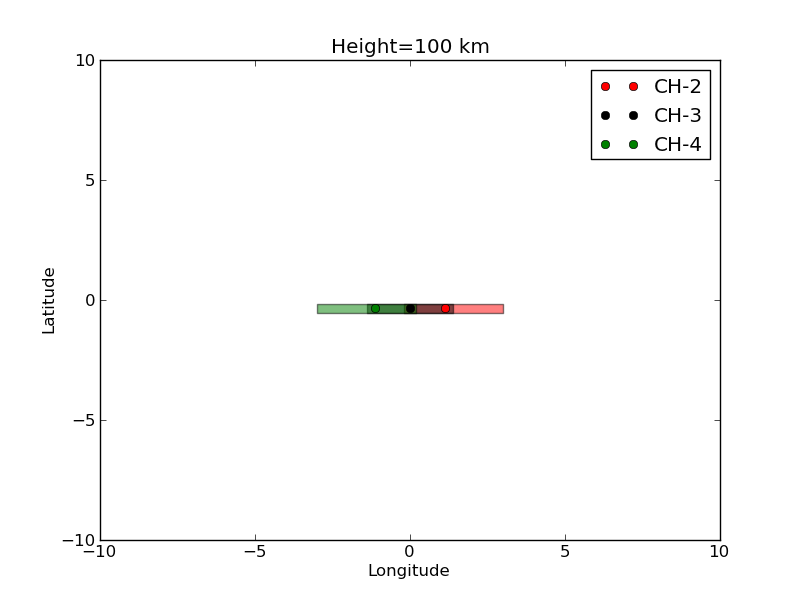cena_visualize_fov¶
This is a script that displays the CENA FoV mapped onto the lunar surface.
The script draw the mapping of the FoV of CENA into the lunar surface.

#!/usr/bin/env python
''' This is a script that displays the CENA FoV mapped onto the lunar surface.
The script draw the mapping of the FoV of CENA into the lunar surface.
.. image:: ../../../src/scripts/cena_visualize_fov.png
'''
import math
import matplotlib as mpl
import matplotlib.pyplot as plt
import irfpy.cena.fov as fov
def map_angle_on_moon(phi, height=100.0):
r''' Map the given angle from nadir in degrees to the lunar surface.
.. note::
This function would be in some module in the future.
:param phi: The angle, :math:`\phi`, between the line of sight and the nadir in degrees.
Centered at the spacecraft.
:keyword height: The height of the s/c in km.
:returns: The selenographic angle, :math:`\theta`, from the footpoint of the spacecraft.
The mapping is a simple geometry.
Here we denote the lunar radius :math:`R=1738` km and the height of the
spacecraft :math:`h`. Also denote :math:`\xi` as a distance from the spacecraft
to the projection point. From simple geometry, you can know
.. math::
R\sin\theta = \xi\sin\phi
(R+h)\sin\theta = \xi\sin(\theta+\phi)
Removing :math:`\xi` from these two equations leads a simple formulation of
.. math::
\theta = \arcsin(\frac{R+h}{R}\sin\phi) - \phi
'''
rmoon = 1738.
radphi = phi * math.pi / 180.
inasin = (rmoon + height) * math.sin(radphi) / rmoon
try:
radasin = math.asin(inasin)
degasin = radasin * 180. / math.pi
except ValueError:
return float('nan')
return degasin - phi
if __name__ == '__main__':
# Define the spacecraft height.
h = 100.
# First, calculate the FoVs and their FWHMs.
azim_center = [fov.azim_pix_center(i) for i in range(7)]
azim_fwhm = [fov.azim_pix_fwhm(i) for i in range(7)]
# In the elevation direction
elev_center = [fov.elev_pix_center(i) for i in range(7)]
elev_fwhm = [fov.elev_pix_fwhm(i) for i in range(7)]
# Prepare the canbus
fig = plt.figure()
ax = fig.add_subplot(111)
# For CH-2 to 4
colors = [None, 'b', 'r', 'k', 'g', 'm', None]
for ch in range(2, 5):
t0 = azim_center[ch] - azim_fwhm[ch] / 2.0
t1 = azim_center[ch] + azim_fwhm[ch] / 2.0
p0 = elev_center[ch] - elev_fwhm[ch] / 2.0
p1 = elev_center[ch] + elev_fwhm[ch] / 2.0
t0m = map_angle_on_moon(t0, height=h)
t1m = map_angle_on_moon(t1, height=h)
p0m = map_angle_on_moon(p0, height=h)
p1m = map_angle_on_moon(p1, height=h)
tc = map_angle_on_moon(azim_center[ch])
pc = map_angle_on_moon(elev_center[ch])
print('CH-', ch, tc, pc, "/", t0m, t1m, p0m, p1m)
rec = mpl.patches.Rectangle((t0m, p0m), t1m - t0m, p1m - p0m,
alpha=0.5, fc=colors[ch])
ax.add_patch(rec)
ax.plot([tc], [pc], colors[ch] + 'o', label='CH-%01d' % ch)
ax.set_xlim(-10, 10)
ax.set_ylim(-10, 10)
ax.legend()
ax.set_title('Height=%g km' % h)
ax.set_xlabel('Longitude')
ax.set_ylabel('Latitude')
fig.savefig(__file__[:-3] + '.png')